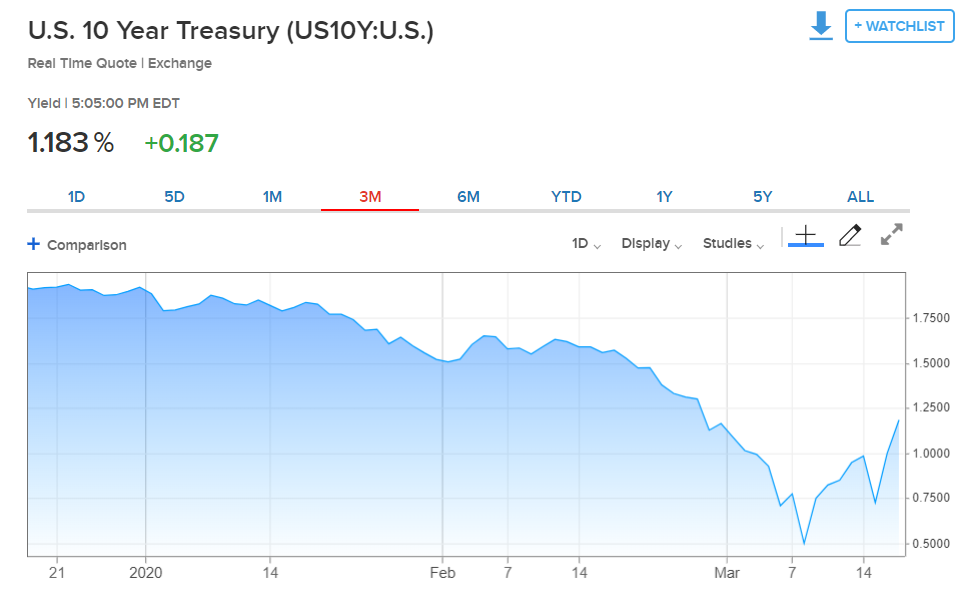Summary: The US Dollar tsunami sent currencies around the world tumbling as company funding demand spiralled out of control. Sterling was the hardest hit among the majors, plummeting to 1.1450, its lowest level since the October 2016 flash crash. GBP/USD was trading at 1.1585 in late New York, a loss of 4.2%. The number of coronavirus deaths in the UK doubled in the past 24 hours, bringing to question Britain’s soft approach to the pandemic. Commodity currencies the Australian and New Zealand Dollar touched multi-year lows. The Aussie extended its slump to an overnight and 2003 low at 0.5702, before bouncing to close at 0.5790, down 3.2%. NZD/USD finished at 0.5760 from 0.5930, a loss of 3.3% after notching a 2009 low at 0.5695. USD/CAD soared to 1.4651 fresh 4-year highs as Crude Oil prices slumped anew. USD/CAD eased to settle at 1.4462. The Euro fell victim to King Dollar, slumping 1.02% to 1.0897 in early Sydney after touching 1.0802, 2017 lows. The Dollar decimated the Emerging Market Currencies. Against the Russian Rouble, the Greenback was up 8.05% at 80.88 (75.30). Brent Crude Oil prices spiralled lower, finishing at USD 27.50 from yesterday’s USD 29.70.
Equities slumped anew. In late New York trade the DOW was 4.5% down to 19,995 (21,110). The S&P 500 lost 3.0% to 2.410 (2,530). Bond markets slumped as borrowing costs from companies around the globe surged. Treasury yields jumped. The key US 10-year bond yield was up 11 basis points to 1.19%, its highest level since late February. Germany’s 10-year Bund yield jumped 25 basis points to -0.25%.
The Eurozone Final Headline CPI rose an annualised 1.2% in February, matching forecasts. Canada’s Headline CPI (February) rose 0.4%, equalling forecasts. US Building Permits in February dropped to 1.46 million units from January’s 1.55 million. Housing Starts climbed to 1.60 million units from the previous month’s 1.57 million.

On the Lookout: Demand for the US Dollar remains strong and its difficult to see anything in the way of the tsunami its created. Global markets are in panic mode because of the coronavirus outbreak and harsh actions to tame it. Monetary measures introduced by the central banks and multibillion Dollar stimulus by governments have failed to restore investor confidence.
Today the focus is on the Australian Employment report for February (11.30 am Sydney time) ahead of the RBA rate decision (2.30 pm Sydney time). Australia is expected to have created 10,000 jobs in February from January’s 13,500. RBA Governor Philip Lowe speaks at a press conference in Sydney following the meeting (4 pm Sydney).
New Zealand reported that its Q4 GDP growth was at 0.5%, matching forecasts of 0.5%. Data releases that follow start with Japan’s National Core CPI report and All Industry Activity Index. Switzerland follows with its Trade Balance. The Swiss National Bank has its rate policy meeting (7.30 pm Sydney). Eurozone Construction Output follows. US data start with Philadelphia Fed Manufacturing Index, US Current Account, Weekly Unemployment Claims, Conference Board Leading Indicators.
Trading Perspective: The Dollars demand is a direct result of liquidity concerns as companies need Dollars to settle transactions. The Fed and other central banks will coordinate to provide that Dollar liquidity across the globe through swap lines established for this purpose. Which will in turn see Dollar demand and the Greenback ease. Against the EM currencies, USD strength has spiralled out of control and we can expect intervention from some of the EM countries to ease the pressure on their currencies. FX moves have been swift and the best way to trade is to get in and out quickly. Don’t get married to any views, pick your ranges and trade accordingly.















